GLC Metal Deck List - Light Metal
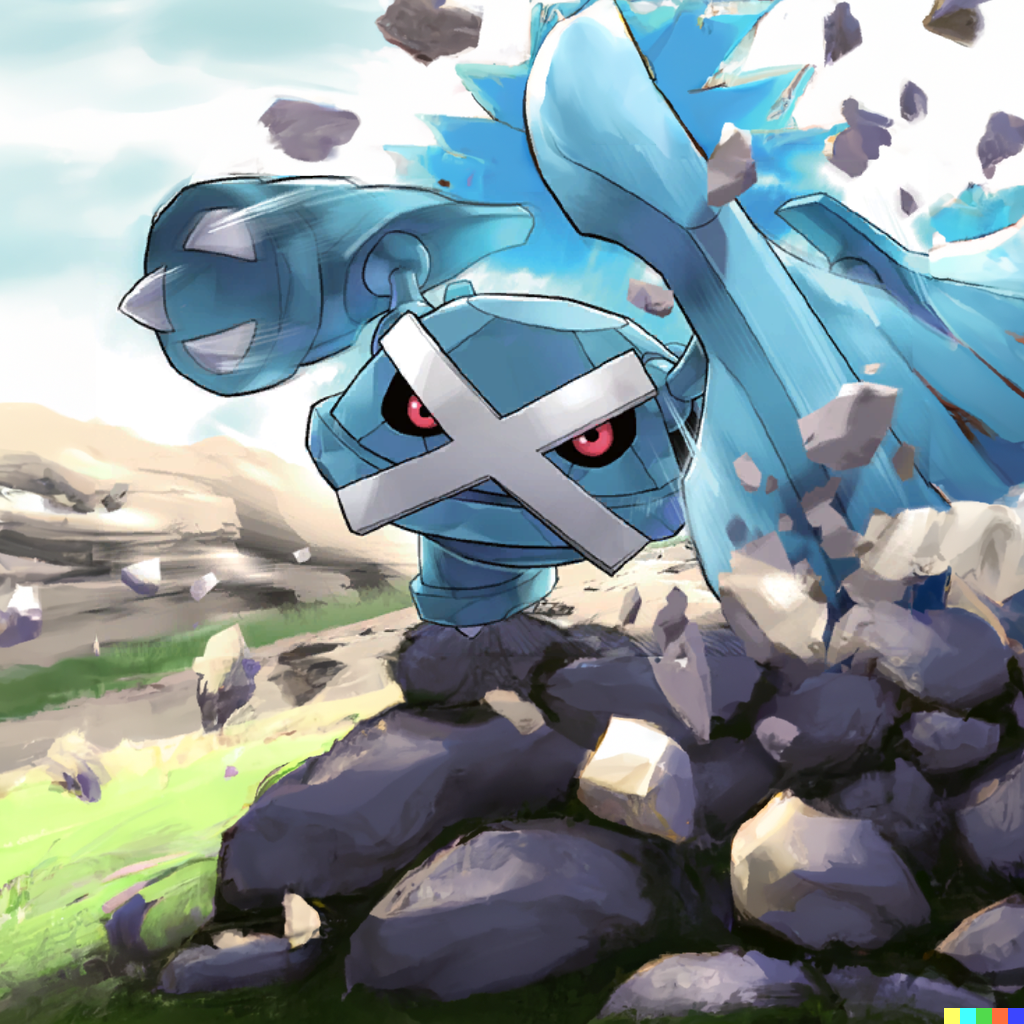

Light Metal
Hello everyone! I’m D34D_M4N14C, and I’ll be taking you all through my thought process behind light metal, as well as my choices for the cards in the list. I made this list mostly because I was missing the stuff for standard Metalzone and wanted to build something with Pokéstop. Thus, after 30 minutes of talking with Accoblubber, and some later changes, I came out with this list:
Without further ado, I’d like to talk about the thing I’ve been obsessing over for the past month.
Pokémon Choice
I knew I wanted to build around the Metagross from the start. I love the idea of a stage 2 coming out for free if a condition is met, and I like that it draws you cards as well. Palabug has Empoleon, most of my grass lists have Beedrill, and now this metal list has Metagross. Unfortunately, Metagross has a much more complicated condition: you have to top deck it at the start of your turn. Because I needed to dedicate more deck space to it, I needed to make sure that my attackers weren’t too complicated to set up. Enter Bisharp TEU and Zacian CRZ, the early/mid game demons:
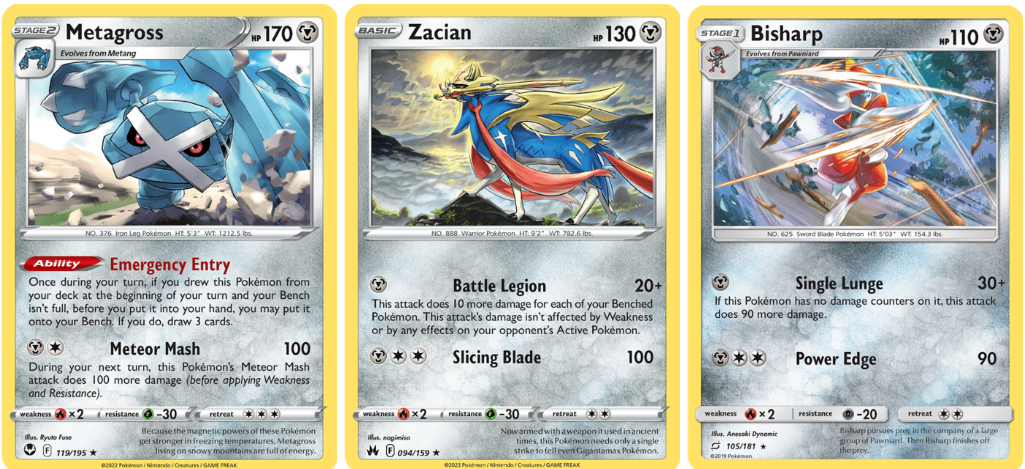
When I was digging through all my old bulk, I rediscovered all of my old Sun and Moon cards. Outside of the other fun GLC stuff I found, this Bisharp really caught my eye. A fast, powerful, and cheap attacker that can hit extremely relevant numbers with Perrserker SVI, which I was already planning on putting into a build at some point.
When the cards from Crown Zenith got revealed, Zacian immediately.captured my interest. I couldn’t think of any way to use it in Standard at the time, but I kept it in the back of my mind just in case it could be useful in the future. It, like Bisharp, is a fast and cheap attacker. The lower power is a welcomed trade off for the ability to hit for 90 damage on turn one (assuming you get lucky). Zacian is also a great starting basic. Additionally, It is to be able to take KOs on your opponent’s evolving basics for just two cards (the Zacian and the energy) while also not being made of paper.
These two mons are your main focus in the early game and will supplement your damage while you set up metagross to be top decked. If you can get Metagross out early, it can be incredibly difficult for your opponent to deal with. If it's combined with shield energy or metal goggles and Perrserker’s damage boost, you can gust up support mons to OHKO while ensuring that your opponent’s next active gets knocked out if the Big Guy is left alive.
End Game Attackers
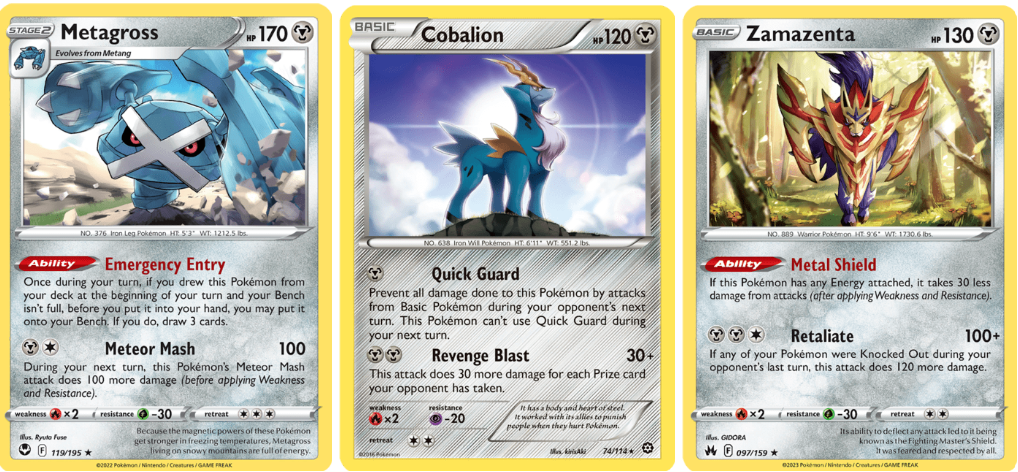
It’s Metagross again, and he brought some hard hitting buddies into the late game with him. Zamazenta and Cobalion, in combination with Metagross, are the backbone of your later turns. This Zamazenta is the one that everyone knows and loves; it hits for good damage and is able to tank hits when needed. Additionally, with Perrserker and muscle band, you’re able to reach the coveted 260 for the extremely relevant Lux-Caped Snorlax! The stars have to align for that to happen, but when do they not vs turbo colorless?
In addition to Zamazenta, Cobalion is a good, cheap attacker that can be used earlier than in most other decks due to Perrserker fixing up the math. Metagross and Zamazenta being tanky also helps you skew the prize trade in your favor. If an opponent is forced to swing into either of them for a non-lethal amount of damage, 9 times out of 10 you just sweep the game from there. Using Quick Guard with Cobalion can also be nice to buy yourself a bit of extra time vs decks with heavier basic counts.
Supportive Lineup
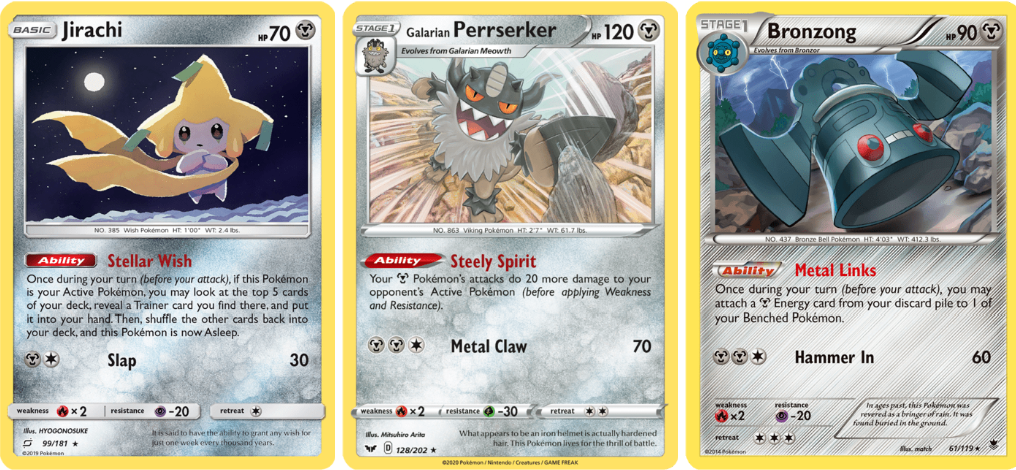
The supporting Pokémon in this deck take on 3 distinct roles. They all help accelerate your game plan in different ways, and should be prioritized over the others based on what matchup you’re playing into. Metagross is also a support Pokémon! I just won’t be talking about him in this section due to the amount of times I’m mentioning him in other parts.
Jirachi is the second most important card in this deck. Stellar Wish is an absolutely amazing ability that should be exploited in every single metal deck. Getting one Trainer card of your choice from the top five cards of your deck is essential for pulling off the combos this archetype requires. Additionally, since its ability requires Jirachi to be in the active spot, it keeps your attacking Pokémon on the bench to use Bronzong's Metal Links ability and metal saucer
Bronzong does what discard accelerators do best and gets your attackers charged up quickly and efficiently. Almost half of all energy I attach to my Pokémon comes from this one card. It’s also the key to answering the fast, aggressive decks coming out of the Paradox Rift meta. As long as you have a pivot, such as Jirachi, Bronzong will keep your benched hungry guys fed with all the energy they’ll ever need.
And finally, Perrserker. This is the most underrated card I’ve ever seen. 20 extra damage is the difference between hitting or whiffing a knockout in so many situations that I don’t think this deck would be playable without it. With Perrserker, you can achieve the following: Bisharp hitting 130+, Zacian can ramp up faster and OHKO 90hp basics and supportive stage 1s, Metagross can hit 120, Zamazenta hits 240 for Wailord, and Cobalion can sneak KOs at 3 prizes instead of 4. There are so many times where I would’ve failed to take an important KO without him, which is why I think Perrserker is key to this deck. As if that weren’t enough, Meowth’s ability makes it extremely easy to get out. It also synergizes with any of the cards in the deck that you want to discard!
Trainer choices
There are a lot of choices I had to make when it came to the trainer lines. I won’t be talking about the staples you’d find in every deck, as that would make this article a bit too long. Instead, here’s the decisions behind all of the more unique choices.

I’ll start with the 3 most important trainers for Metagross: Max Revive, Switching Cups, and Mallow. All three of these cards allow you to set him up on top of the deck from different zones. Max Revive covers your discard pile, and has extra synergy with Pokestop discards and Battle Compressor. Switching Cups covers your hand whenever you start the game with Metagross or Evolution Incense. Mallow covers the rest of your cards, and also guarantees that one of the three cards you get with Metagross’ ability will be useful on the following turn. Mallow also gives some extra use to Pokestop and Bicycle, allowing you to choose what cards you want to draw next. Light Metal would be far worse without these three cards.
In order to effectively use these cards to your full advantage, you need a powerful engine. I decided to not use Revavroom, since it takes up space on my already crowded bench, and instead chose to build the deck around my current fixation of the time: Pokestop.
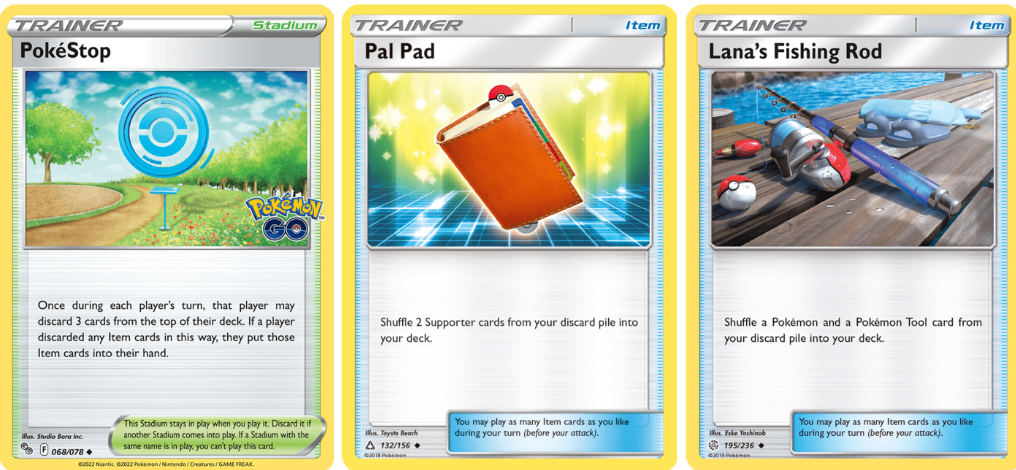
Pokestop is an insane card when your deck is built around it. A lot of the time, you get 2 cards at the cost of discarding one other card. Sometimes you get 3! But the great part is that even if you do strike out and discard 3 non-items, you’re thinning the deck to find the other important cards that you’ll need later on, such as gust supporters, Raihan, or Klara. Using Pokestop can help you find Pokemon, Energy, or even Supporters, when combined with the likes of VS Seeker and ball search. However, it’s important to note what resources you do and don’t have each time before hitting the Pokestop, especially in the late game. Trying to high roll into a Pokegear just to discard the supporter you were trying to get is the worst feeling ever. Light Metal plays quite a few recovery cards due to Pokestop. Pal Pad and VS Seeker help you get your supporters back, and Rescue Stretcher and Lana’s Fishing rod cover you for bad Pokemon discards. Lana’s Fishing Rod is an especially important card in this deck, due to Jirachi needing Escape Board. Most decks don’t play two forms of tool removal, so once they Field Blower the board, you can use the rod to get it back and keep using Jirachi with no added switching cards.

Finally, I’ll go over a few of the more non-traditional trainer choices in the deck. Capturing Aroma is not a common card in many lists in both Standard and GLC, which I think is a shame. I think this card is underrated in single prize decks, both in GLC and in Standard. Usually, at any given point, you need to find a basic and an evolution Pokemon. Capturing Aroma gives you one of these pokemon for no additional cost! Additionally, in this deck, flipping heads on Aroma early doesn’t matter as much as other decks due to searching out Metagross for max Revive or Bisharp for a turn two knockout.
Scoop Up Net is a surprisingly important card in this deck. I’ve found its main use is to pick up a damaged Bisharp to use later in the match. You can also pick up a damaged Zamazenta or Zacian to deny a prize, or pick up Cobalion if he finds himself starting in the active spot. I’ve even used Net to scoop up my damaged Metagross, only to use an Ultra Ball to discard it and then use Max Revive to put him back on top of the deck!
Metal Goggles is my damage reduction tool of choice. The ability to prevent damage counters from being placed on the Pokemon it is attached to cannot be understated. I’ve found it to be most effective on Bisharp in order to keep him damage free and ready to Single Lunge for full damage. Also, it makes Metagross and Zamazenta almost impossible to OHKO. That being said; if your local GLC scene is filled with fire decks and very few spread decks, Metal Frying Pan is probably better.
Next I’d like to talk about general gameplay lines and how I approach matchups. No matter what matchup, I try to get Jirachi out to start getting the cards I need. From there, I switch up my strategy (as long as I don’t prize too many Pokemon).
Vs faster decks, I prioritize getting out Bronzong first. Most of the time you need to be following up on knock out after knock out, and Bronzong is the only way to do this consistently. I like to prioritize Zacian and Bisharp (in that order) in the early game. This doesn’t change too much against other archetypes, but Zacian should be taking the first KO. After those mons, try to do your best to get Metagross up and running. He will usually be able to tank a hit (not against Snorlax) which will help further skew the prize trade in your favor. Otherwise, use Zamazenta.
Vs slower decks, I try to get Metagross out ASAP. He can and will run over your opponent with the help of Perrserker, which is the first evolution line I try to get out. You still want to start attacking with Zacian of course, since you’ll be able to steal KOs on your opponent’s evolving basics. Once your opponent is set up, you want to keep up the pressure with gust KOs on important support targets, which should be prioritized based on where you are in the match. I’ve found that taking out energy acceleration early game and draw support late game, or when your opponent has a small hand, are the best times to do so. Then, you want to prioritize getting Zamazenta out to threaten a revenge KO on a tanky attacker.
Possible Additions
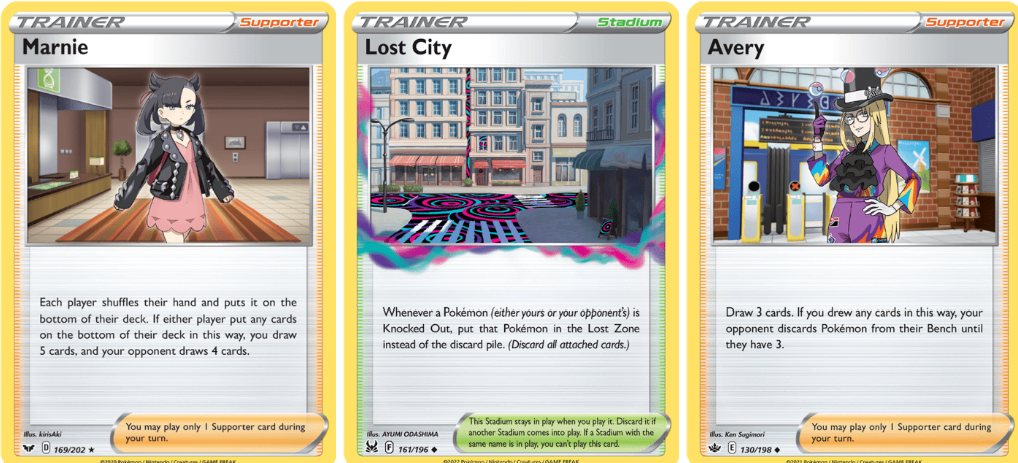
While this deck runs great on its own, sometimes you want a card to disrupt the board state of your opponent. Marnie, Avery, and lost city are all cards that can disrupt gameplans very well. Vs setup decks, Avery + KO can decimate their boardstate and make them unable to catch up. An early Marnie can be ruinous for any deck that happens to not draw well out of it, and is not terrible in the later games. I’d probably trade out Colress for one of these two. Colress’ draw can be a huge boon to your setup, but sometimes the potential disruption could be better. Finally, Lost City is an incredible tool at dealing with decks that like to recur their best attacker, such as a certain blue sloth that terrorizes the metagame. Losing your attacker is an unfortunate side effect of the card. However, with Metagross and Zamazenta, you may be able to tank a hit and bump the stadium after.
I hope you all enjoyed reading this article! Light Metal was a really fun deck to play over webcam and in person, and I’m really glad that I got the opportunity to shed a new light onto metal and show off just how powerful this list can be. Setting up Metagross feels great every time you get it off, and you get it off in every game (sometimes twice!). Hopefully, those who read this whole thing through and decide to build the deck are able to get the same sense of enjoyment I have when I play it.